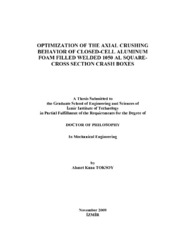Please use this identifier to cite or link to this item:
https://hdl.handle.net/11147/2894Full metadata record
| DC Field | Value | Language |
|---|---|---|
| dc.contributor.advisor | Güden, Mustafa | en |
| dc.contributor.author | Toksoy, Ahmet Kaan | - |
| dc.date.accessioned | 2014-07-22T13:48:34Z | - |
| dc.date.available | 2014-07-22T13:48:34Z | - |
| dc.date.issued | 2009 | en |
| dc.identifier.uri | http://hdl.handle.net/11147/2894 | - |
| dc.description | Thesis (Master)--Izmir Institute of Technology, Mechanical Engineering, Izmir, 2009 | en |
| dc.description | Includes bibliographical references (leaves: 194-209) | en |
| dc.description | Text in English; abstract: Turkish and English | en |
| dc.description | xx, 211 leaves | en |
| dc.description.abstract | The crushing behavior of partially Al closed-cell foam (Alulight AlSi10) filled 1050H14 Al crash boxes was investigated at quasi-static and dynamic deformation velocities. The quasi-static crushing of empty and filled boxes was further simulated using LS-DYNA. Finally, the crushing of partially foam filled 1050H14 crash boxes was optimized using the response surface methodology. The used optimization methodology was also applied to the boxes made of a stronger Al alloy, 6061T4 Al, and filled with a higher strength Al foam, Hydro Al closed cell foam, in order to clarify the effect of box material and foam filler strength on the crushing behavior of the filled boxes. Within the investigated tube thickness and foam relative density range, the energy absorption of 1050H14 boxes was optimized at 3 mm wall thickness and 0.1114 (Alulight) and 0.0508 (Hydro foam) foam filler relative density. The increase in specific energy absorption of 1050H14 crash box was 5.6% with Alulight and 21.9% for Hydro foam filling. The SEA values of empty, partially and fully foam filled boxes were predicted as function of box wall thickness between 1 and 3 mm and foam filler relative density between 0 and 0.2, using the analytical equations developed for the mean crushing loads. The analysis indicated that both fully and partially foam filled boxes were energetically more efficient than empty boxes above a critical foam filler relative density. Partial foam filling however decreased the critical foam filler density at increasing box wall thicknesses. | en |
| dc.language.iso | en | en_US |
| dc.publisher | Izmir Institute of Technology | en |
| dc.rights | info:eu-repo/semantics/openAccess | en_US |
| dc.subject.lcc | TA417.7.C65 .T64 2009 | en |
| dc.subject.lcsh | Materials--Compression testing | en |
| dc.subject.lcsh | Aluminum foam | en |
| dc.title | Optimization of the axial crushing behavior of closed-cell aluminum foam filled welded 1050 al square-cross section crashboxes | en_US |
| dc.type | Doctoral Thesis | en_US |
| dc.department | Thesis (Master)--İzmir Institute of Technology, Mechanical Engineering | en_US |
| dc.relation.publicationcategory | Tez | en_US |
| item.openairecristype | http://purl.org/coar/resource_type/c_18cf | - |
| item.grantfulltext | open | - |
| item.cerifentitytype | Publications | - |
| item.fulltext | With Fulltext | - |
| item.openairetype | Doctoral Thesis | - |
| item.languageiso639-1 | en | - |
| Appears in Collections: | Phd Degree / Doktora | |
Files in This Item:
| File | Description | Size | Format | |
|---|---|---|---|---|
| T000316.pdf | DoctoralThesis | 22.83 MB | Adobe PDF |  View/Open |
CORE Recommender
Page view(s)
256
checked on Nov 18, 2024
Download(s)
156
checked on Nov 18, 2024
Google ScholarTM
Check
Items in GCRIS Repository are protected by copyright, with all rights reserved, unless otherwise indicated.